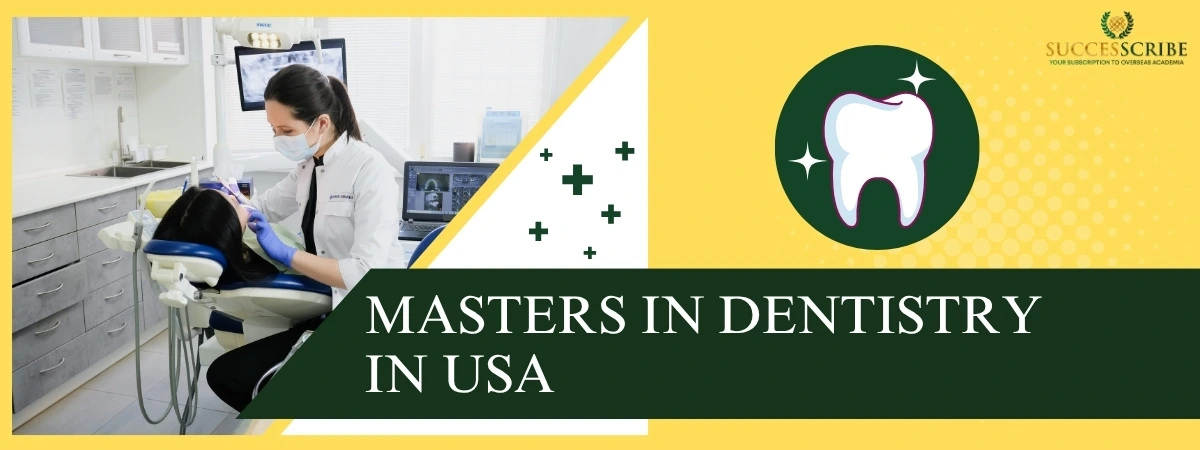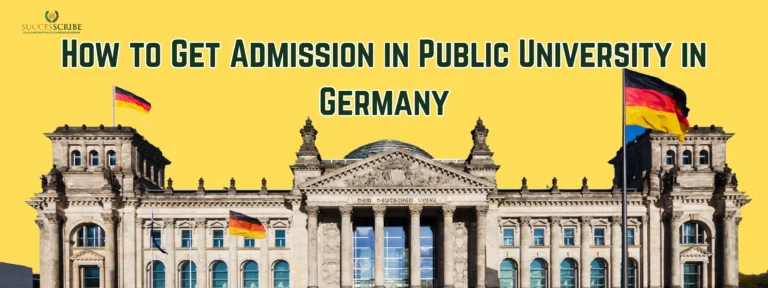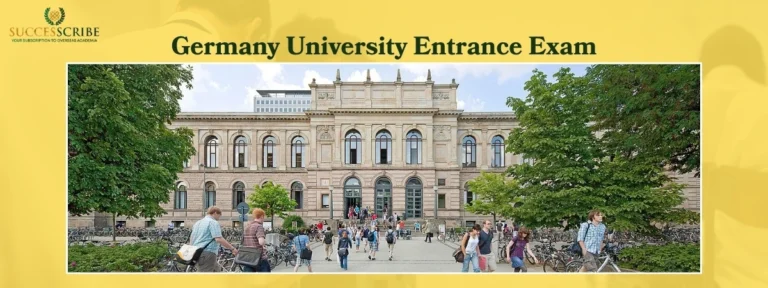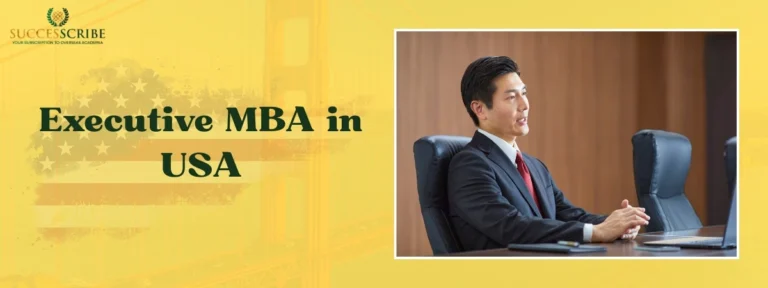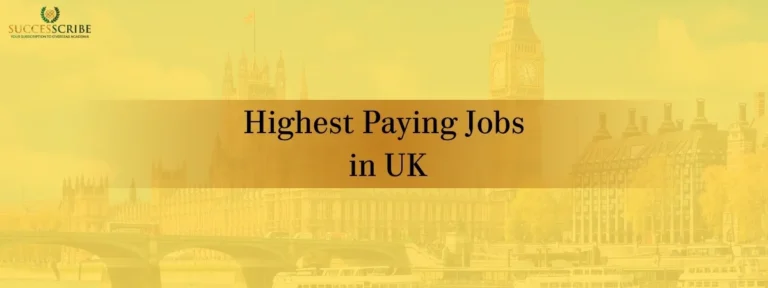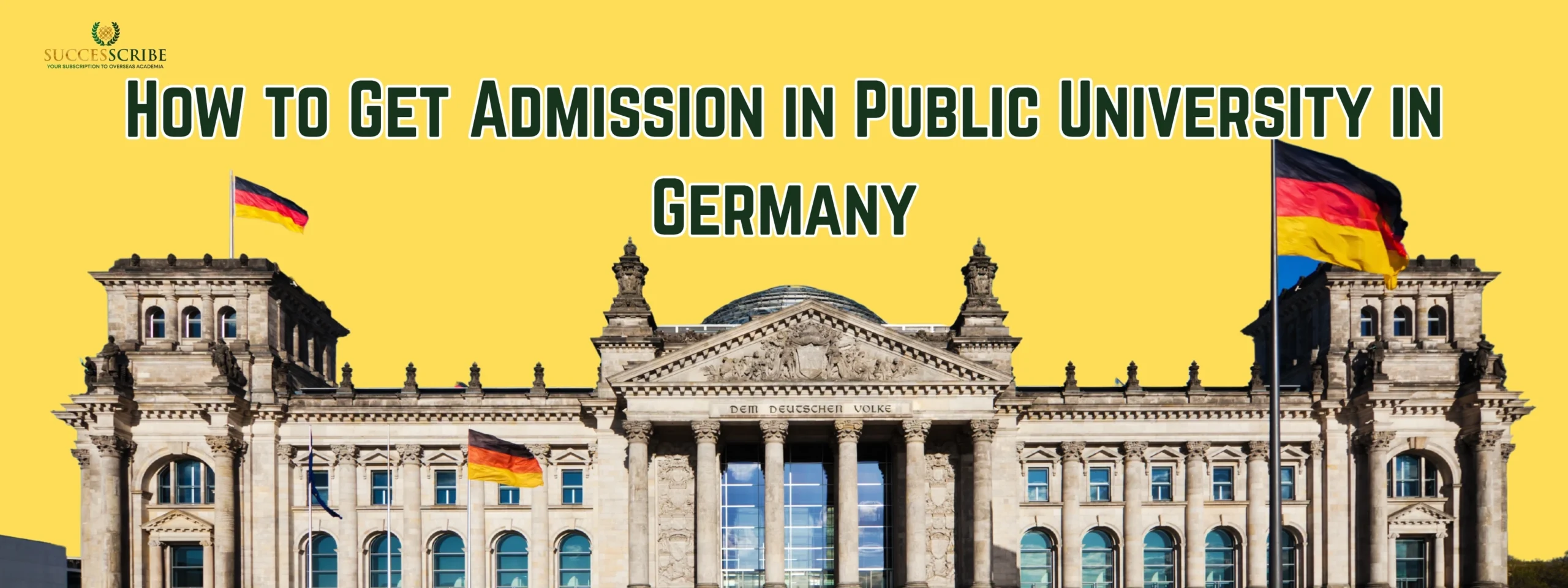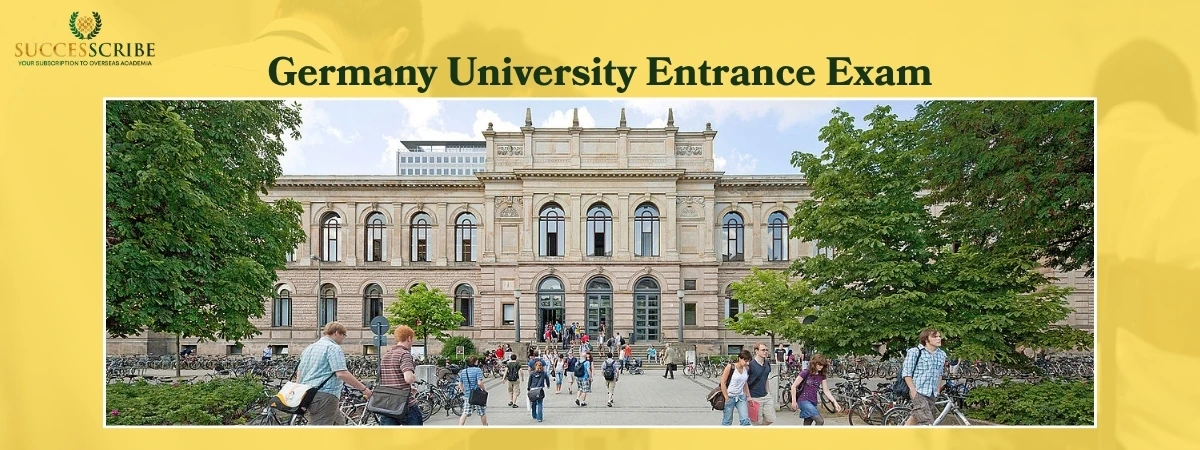Dentistry is one of the most respected and rewarding professions globally, offering not only a solid career but also the opportunity to make a meaningful impact on people’s health and well-being. The United States, known for its advanced medical and dental education, has become a sought-after destination for aspiring dentists worldwide. A Master’s in Dentistry in the USA is designed for professionals seeking specialization, research, or academic careers in dental science.
This topic provides an in-depth look at pursuing a Masters in Dentistry in USA including top programs, eligibility, tuition costs, specializations, career opportunities, and more.
Overview of Dentistry Education in the USA
Dental education in the USA is highly structured and regulated to ensure the highest standards of practice. The American Dental Association (ADA) plays a pivotal role through its Commission on Dental Accreditation (CODA), which accredits dental education programs. Typically, the pathway to becoming a dentist involves completing a bachelor’s degree, followed by a Doctor of Dental Surgery (DDS) or Doctor of Dental Medicine (DMD) degree. Advanced studies, such as Master’s programs, allow dentists to specialize in various fields.
Top Specializations in Masters in Dentistry in USA
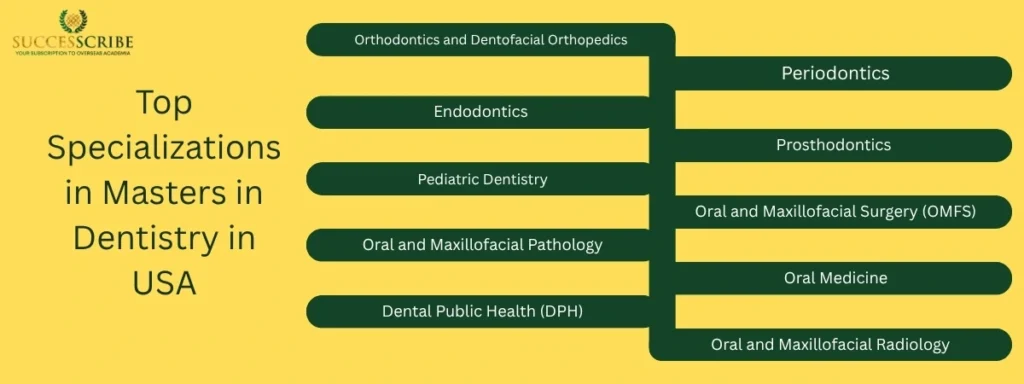
Pursuing a Masters in Dentistry in USA allows students to specialize in various high-demand fields that go beyond general dental practice. These specializations are designed to provide in-depth clinical, academic, and research training in specific areas of dental medicine, typically accredited by the Commission on Dental Accreditation (CODA) and aligned with American Dental Association (ADA) standards.
Below is a comprehensive list of the most recognized and in-demand dental specializations offered at leading U.S. institutions:
| Specialization | Description | Typical Program Duration |
| Orthodontics and Dentofacial Orthopedics | Focuses on diagnosing and correcting misaligned teeth, jaws, and bite irregularities using braces, aligners, and surgical orthodontics. | 2–3 years |
| Periodontics | Specializes in the prevention, diagnosis, and treatment of periodontal (gum) disease, including implant placement and gum graft surgeries. | 2–3 years |
| Endodontics | Centers on diseases and injuries of the dental pulp and roots, primarily involving root canal treatments and microsurgery. | 2 years |
| Prosthodontics | Involves restoring and replacing teeth using crowns, bridges, dentures, veneers, and implants. Ideal for cosmetic and reconstructive dentistry. | 3 years |
| Pediatric Dentistry | Deals with comprehensive dental care for children, infants, and adolescents, including those with special healthcare needs. | 2 years |
| Oral and Maxillofacial Surgery (OMFS) | A surgical specialty focusing on complex procedures like jaw reconstruction, wisdom teeth removal, facial trauma, cleft palate repair, and TMJ disorders. | 4–6 years (Residency + Optional MS) |
| Oral and Maxillofacial Pathology | Concerned with the diagnosis and study of diseases affecting the oral and maxillofacial regions through biopsy, histopathology, and lab sciences. | 3 years |
| Oral Medicine | Focuses on diagnosing and managing medically related disorders of the mouth, such as oral cancers, autoimmune diseases, and chronic pain. | 2–3 years |
| Dental Public Health (DPH) | Combines dentistry and public health to address community oral health issues through policy, education, epidemiology, and preventive care programs. Often offered as an MPH + Dental focus. | 2 years |
| Oral and Maxillofacial Radiology | Specializes in the use and interpretation of imaging technologies like X-rays, CBCT, and MRI for head and neck diagnosis. | 2 – 3 years |
Suggested Post: Aerospace engineering courses in USA
Top Universities for Masters in Dentistry in USA
Based on current accreditation and rankings, here are the leading universities offering Master’s degree programs in dentistry and dental specializations:
| University | Program(s) Offered |
| Harvard School of Dental Medicine | – MMSc in Oral Biology- MMSc in Dental Education- MMSc in Clinical Specialties (Ortho, Endo, etc.) |
| University of California, San Francisco (UCSF) | – MS in Oral and Craniofacial Sciences- MS with Certificate in Orthodontics, Periodontics, etc. |
| University of Michigan, Ann Arbor | – MS in Oral Health Sciences- MS in Prosthodontics, Orthodontics, Endodontics, etc. |
| University of North Carolina at Chapel Hill | – MS in Oral Biology- MS in Dental Specialties (Pediatric Dentistry, Ortho, Perio, etc.) |
| University of Pennsylvania (Penn Dental Medicine) | – MS in Oral Biology- MS with Specialty Certifications |
| Boston University Henry M. Goldman School of Dental Medicine | – MS in Dental Public Health- MSD in Periodontology, Endodontics, Prosthodontics, etc. |
| New York University (NYU) College of Dentistry | – MS in Biomaterials- Advanced Certificate + MS in Ortho, Perio, Endo, etc. |
| University of Southern California (USC) Herman Ostrow School of Dentistry | – MS in Craniofacial Biology- Advanced Specialty Training + MS Programs |
| Columbia University College of Dental Medicine | – MS in Periodontics, Endodontics, Orthodontics, etc. (with research emphasis) |
| University of Illinois Chicago (UIC) | – MS in Oral Sciences- MS with certificate in Ortho, Pediatric, Endo, etc. |
| University of Washington School of Dentistry | – MS in Oral Biology- Graduate Specialty Certificates + MS (e.g., Ortho, Perio) |
| University of Texas Health Science Center at Houston (UTHealth Houston) | – MS in Dentistry (Ortho, Perio, Pediatric Dentistry, etc.) |
| University at Buffalo School of Dental Medicine (SUNY Buffalo) | – MS in Oral Sciences- Specialty MS programs in Endodontics, Orthodontics, etc. |
| Tufts University School of Dental Medicine | – MS in Dental Research- MS with Specialty Certificates (Ortho, Perio, etc.) |
| University of Florida College of Dentistry | – MS in Dental Sciences- MS with Advanced Education in Dental Specialties |
Suggested Post: Duolingo accepting universities in USA
Eligibility Criteria for Masters in Dentistry in the USA
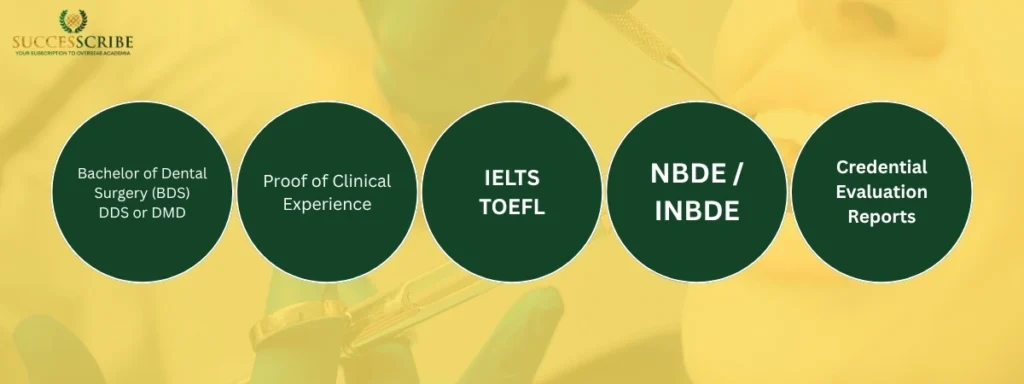
Gaining admission into a Master’s program in Dentistry in the United States is highly competitive and requires applicants to meet a comprehensive set of academic, professional, and language criteria. While specific requirements may vary slightly across institutions and specializations, the following are the universally accepted eligibility standards for most Master’s and postgraduate dental programs in the USA.
1. Educational Qualifications
For Clinical Specialization Programs (e.g., MS in Orthodontics, Periodontics, Endodontics, Prosthodontics, etc.)
- A Bachelor of Dental Surgery (BDS) or an equivalent dental degree (e.g., DDS or DMD) from a recognized dental school.
- The degree must be equivalent to a U.S. dental degree as evaluated by Educational Credential Evaluators (ECE) or World Education Services (WES).
- Minimum academic performance: A Grade Point Average (GPA) of 3.0 or above on a 4.0 scale is often required (some top schools may require 3.3+).
For Research-Based MS Programs (e.g., MS in Oral Biology, Craniofacial Sciences):
- A dental degree is usually required, but some programs also accept applicants with a bachelor’s or master’s in biomedical sciences, life sciences, or related fields.
- Research background or publications can be an added advantage.
2. English Language Proficiency
All international applicants must demonstrate proficiency in English through standardized tests, unless they’ve studied in an English-speaking country.
| Test | Minimum Required Score |
| IELTS | 6.5–7.5 overall (no band less than 6.0) |
| TOEFL iBT | 90–100 overall (with 22+ in each section preferred) |
Minimum score requirements vary slightly between programs, and top-tier universities may require higher scores.
3. Standardized Tests (if applicable)
NBDE / INBDE (for Advanced Standing or Clinical Programs):
- INBDE (Integrated National Board Dental Examination) has replaced NBDE Part I and II as the standard exam.
- Required only for DDS/DMD Advanced Standing Programs (not typically required for research-based MS programs).
- Some MS in clinical specialties (e.g., Endodontics, Orthodontics) may request INBDE scores as a competitive advantage, though not always mandatory.
GRE (Graduate Record Examination):
- GRE is optional for most dental programs but may be required for research-intensive MS or PhD programs in Oral Biology, Craniofacial Sciences, or Biomaterials.
- Recommended score: 300+ combined (Verbal + Quantitative) and 4.0+ in Analytical Writing.
4. Letters of Recommendation (LORs)
- 2–3 strong letters of recommendation are typically required.
- Must be from professors, clinical supervisors, or research mentors who can vouch for the applicant’s academic capability, clinical skills, and research potential.
- Some programs require at least one letter from a dental school dean or head of department.
5. Statement of Purpose (SOP) / Personal Statement
- A well-written SOP (1–2 pages) outlining:
- Motivation to pursue a Master’s in Dentistry.
- Specific interests in the chosen specialization.
- Academic and clinical background.
- Career goals after graduation.
For research programs, a clear mention of intended research area or thesis interest is essential.
6. Resume or CV
Must include:
- Academic background.
- Clinical internships and work experience.
- Research projects/publications (if any).
- Professional certifications.
- Volunteer or leadership activities.
7. Proof of Clinical Experience (For Clinical Specialties)
- Most clinical Master’s programs expect applicants to have at least 1–2 years of post-BDS clinical experience.
- Hands-on exposure in the relevant specialty (e.g., orthodontics, pediatric dentistry) is a plus.
Some programs may ask for:
- Logbook of procedures.
- Clinical photographs or case presentations.
- Proof of internship/residency in home country.
8. Credential Evaluation Reports
Applicants with foreign degrees must submit a credential evaluation from a recognized service provider
| Accepted Agencies | Report Type Needed |
| WES | Course-by-Course Evaluation |
| ECE | Course-by-Course with GPA equivalent |
| NACES members | Depends on school preference |
9. Interviews (if shortlisted)
Most universities conduct online interviews via Zoom or Skype.
Questions may assess:
- Clinical knowledge.
- Understanding of U.S. dental system.
- Communication skills.
- Research or academic goals.
10. Financial Proof (for I-20/Student Visa)
To obtain an I-20 form and apply for an F-1 student visa, you must provide:
- Bank statements showing funds equal to at least one year of tuition + living expenses (typically $70,000–$100,000).
- Financial affidavit or sponsor letter (if needed).
- Scholarship/fellowship letters, if awarded.
Suggested Post: Engineering management courses in USA
Licensing and Examination: Can You Practice in the USA After Master’s in Dentistry?
One of the most common questions international students ask is:
“Can I work as a dentist in the USA after completing my Master’s in Dentistry?”
The short answer is: No, not immediately, completing a Master’s in Dentistry does not give you the legal right to practice dentistry in the U.S.
Why a Master’s Degree Alone Isn’t Enough
In the U.S., only those who hold a Doctor of Dental Surgery (DDS) or Doctor of Dental Medicine (DMD) degree from a CODA-accredited dental school are legally permitted to practice as licensed dentists.
A Master’s degree (MS/MDS), even in a clinical specialty like orthodontics or periodontics, does not qualify you to treat patients independently unless you have also completed a U.S.-recognized DDS/DMD program.
So What Can You Do with a Master’s in Dentistry in the USA?
| Career Path | Allowed Without DDS/DMD License? | Details |
| Dental Researcher | Yes | Work in labs, universities, or dental companies. |
| University Lecturer | Yes (for theory/research) | Teach preclinical subjects or dental science. |
| Public Health Specialist | Yes (MPH or DPH degree holders) | Work in health policy, NGOs, or government. |
| Clinical Dentist (Private Practice) | No | Requires DDS/DMD and licensure. |
| Specialist (Orthodontist, Endodontist, etc.) | No | Only allowed if U.S. licensure obtained. |
How to Become a Licensed Dentist in the USA (For International Graduates)
If you want to treat patients or open a dental practice in the U.S., you must follow these steps:
Step 1: Complete an Advanced Standing DDS or DMD Program
- Enroll in a 2–3 year DDS/DMD “Advanced Standing Program” offered to international dental graduates.
- These programs are CODA-accredited and lead to a U.S. dental degree.
- You’ll often need:
- INBDE exam results
- IELTS/TOEFL score
- WES evaluation
- Letters of recommendation
- Dental experience in your home country
Step 2: Pass the INBDE Exam
- INBDE (Integrated National Board Dental Examination) is mandatory for licensure.
- Replaced the old NBDE Part I and II exams.
- Tests your knowledge of basic and clinical sciences.
Step 3: Pass a Clinical Licensing Exam
After DDS/DMD, you’ll need to pass a regional clinical board exam, such as:
- ADEX (Accepted in most U.S. states)
- WREB
- CDCA
- CRDTS
Each U.S. state has its dental board; make sure you meet the requirements of the state you have chosen.
Step 4: Apply for State Licensure
- Submit your DDS/DMD degree, exam results, background check, and application fee to your chosen state’s dental board.
- Once approved, you receive a license to practice in that specific state.
Can You Do a Master’s First and DDS Later?
Yes! In fact, many international dentists use a Master’s program in the U.S. as a stepping stone toward eventually applying for DDS/DMD Advanced Standing programs. Benefits include:
- Gaining U.S. academic experience
- Building a strong profile
- Improving chances of admission to DDS/DMD
- Networking with dental faculty
Summary
| Path | Can you practice in US? | Requirements |
| Master’s in Dentistry Only | No | Can work in research, teaching, or public health |
| DDS/DMD (Advanced Standing) | Yes | INBDE + Clinical exam + State license |
If your goal is to work as a practicing dentist in the USA, your long-term plan should include a DDS or DMD from a U.S. dental school.
Suggested Post: Exams required to study in USA
Cost of Studying Masters in Dentistry in the USA
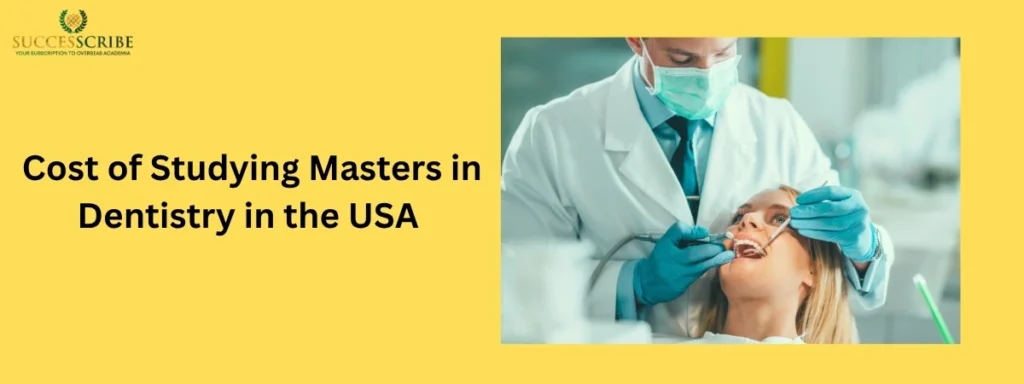
Pursuing a Master’s in Dentistry in the United States is a significant academic and financial commitment. While the return on investment can be substantial in terms of career opportunities, it’s essential to understand the full spectrum of costs involved.
Here’s a detailed breakdown of the major expenses you’ll encounter as an international student in a dental postgraduate program in the U.S., including tuition, living, exam fees, insurance, and more, without reference to specific universities.
1. Tuition Fees
The largest component of the overall cost is the academic tuition. Master’s programs in dentistry, whether clinical (Orthodontics, Periodontics) or research-based (Oral Biology, Biomaterials), are typically offered by dental schools associated with medical institutions, making them more expensive than other graduate programs.
| Program Type | Annual Tuition Range (USD) |
| Clinical Specialization Programs | $50,000 – $80,000 |
| Research-Based MS Programs | $35,000 – $60,000 |
| Dual Programs (e.g., MS + Certificate) | $60,000 – $90,000 |
Clinical programs tend to be costlier due to intensive lab training, equipment use, and patient interaction hours.
2. Living Expenses
Living costs depend on the city, lifestyle, and housing arrangements. Major cities like New York, Boston, or Los Angeles have higher costs compared to smaller college towns.
| Category | Estimated Annual Cost (USD) |
| Accommodation (Shared Apartment) | $10,000 – $15,000 |
| Food and Groceries | $3,000 – $5,000 |
| Local Transportation | $1,200 – $2,000 |
| Utilities & Internet | $1,000 – $1,800 |
| Personal Expenses | $1,500 – $3,000 |
| Total (Per Year) | $18,000 – $27,000 |
On-campus housing is limited for postgrad students. Most opt for off-campus shared apartments.
3. Books, Lab Fees & Supplies
Master’s programs in dentistry often involve the use of specialized tools, textbooks, and laboratory kits.
| Item ` | Estimated Annual Cost (USD) |
| Dental Instruments Kit | $1,000 – $3,000 (one-time) |
| Textbooks & Journals | $500 – $1,000 |
| Lab & Clinic Usage Fees | $1,000 – $2,500/year |
Some programs charge separate “clinic fees” for patient care or equipment usage — check in advance!
4. Health Insurance
Health insurance is mandatory for all international students. Most universities offer their own plans.
| Type | Cost per Year (USD) |
| University-Sponsored Plan | $2,000 – $3,000 |
| Private Insurance Plans | $1,500 – $2,500 (limited coverage) |
University-sponsored plans cover routine checkups, emergencies, and dental emergencies in most cases.
5. Examination and Application Fees
| Fee Type | Official Cost (USD) |
| IELTS Academic | $250 |
| GRE General Test | $220 |
| INBDE (Integrated National Board Dental Examination) | $680 |
| WES Course-by-Course Evaluation | $163 + $50 delivery = $213 |
| ECE Course-by-Course Evaluation | $195 + $50 delivery = $245 |
| University Application Fee | $75 – $150 (each school) |
| ADEA CAAPID Application (DDS route only) | $259 (first school) + $102 for each additional school |
| F-1 Visa Application (Form DS-160) | $185 |
| SEVIS I-901 Fee | $350 |
Suggested Post: Masters in food science and technology in USA
Career Opportunities After Masters in Dentistry in USA

While clinical practice requires licensure, there are several other career paths:
| Career Path | Average Annual Salary (USD) |
| Dental Researcher | $70,000 – $110,000 |
| Dental Public Health Officer | $60,000 – $90,000 |
| University Faculty/Lecturer | $80,000 – $120,000 |
| Oral Biologist | $75,000 – $105,000 |
| Orthodontist (Post-license) | $120,000 – $250,000+ |
| Periodontist (Post-license) | $130,000 – $220,000 |
Suggested Post: Masters in health administration in USA
Pros and Cons of Pursuing a Master’s in Dentistry in the USA

Pursuing a Master’s in Dentistry in the United States is a major academic, financial, and career decision, especially for international students. The USA is home to some of the world’s best dental schools, offering state-of-the-art infrastructure, cutting-edge research, and high-impact specializations. However, the journey is not without challenges.
Pros
- World-Class Education
Study at globally ranked dental schools with advanced facilities.
- Specializations
Options in both clinical (Ortho, Perio) and research areas (Oral Biology, Biomaterials).
- Global Recognition
U.S. degrees boost your international credibility and career prospects.
- Research Opportunities
Work on cutting-edge dental innovations and publish globally.
- Non-Clinical Career Paths
Opens doors in academia, public health, dental R&D, and policy.
- Pathway to DDS/DMD
Strengthens profile for Advanced Standing programs to practice clinically in the U.S.
Cons
- Expensive
Total cost can exceed $150,000–$200,000 for international students.
- Not a License to Practice
MS alone does not allow you to work as a dentist in the U.S.
- Highly Competitive
Requires excellent academics, experience, and test scores.
- Visa & Work Restrictions
Limited post-study work rights without a DDS/DMD degree.
- Few Scholarships
Financial aid options for international students are limited.
Conclusion
A Masters in Dentistry in USA offers international students a unique opportunity to gain advanced knowledge, specialize in clinical or research fields, and grow in a globally respected academic environment. With top-ranked institutions, world-class facilities, and diverse career pathways, it’s an ideal choice for those aiming to deepen their dental expertise. However, it’s important to note that an MS alone does not allow you to practice clinically in the U.S, you’ll need to pursue a DDS/DMD Advanced Standing Program and pass licensing exams to become a licensed dentist.
Still, the Master’s degree is a powerful stepping stone toward research, public health, academia, or even full licensure in the future. If you’re ready to take your dental career to the next level, the U.S. is a destination worth aiming for.
FAQs
Is a Master’s in Dentistry from the USA valid in other countries?
Yes, U.S. degrees in dentistry are globally respected. While clinical practice rights vary by country, a Master’s degree from the USA enhances your academic profile and job prospects worldwide, especially in research, public health, and academics.
Can I practice as a dentist in the USA after completing a Master’s in Dentistry?
No, a Master’s degree alone does not grant you the license to practice general dentistry in the USA. You must complete a CODA-accredited DDS or DMD Advanced Standing Program and pass exams like INBDE and a clinical licensing exam.
How much does it cost to study a Master’s in Dentistry in the USA?
The total cost for international students typically ranges between $150,000 to $200,000, including tuition, living expenses, insurance, and other fees. Clinical specializations tend to be more expensive than research programs.
Can I do a DDS/DMD after completing a Master’s in Dentistry in the USA?
Yes, many international students use a Master’s as a stepping stone to apply for Advanced Standing DDS/DMD programs, which are required to practice as a licensed dentist in the U.S.
What is the difference between a Master’s in Dentistry and a DDS/DMD in the USA?
A Master’s in Dentistry is often research-based or specialty-focused and does not lead to licensure to practice dentistry in the U.S. A DDS/DMD is a professional degree required for clinical practice and must be earned from a CODA-accredited dental school.
Related Post
Fashion designing courses in USA
Fulbright scholarship in USA
Masters in artificial intelligence in USA
Masters in biotechnology in USA

